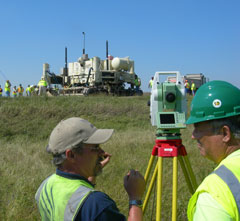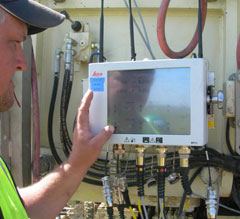 Known for its innovation in concrete pavements, Iowa took another leap forward with its completion of two stringless slipform concrete overlay projects in 2009. Stringless technology, as the name implies, replaces the traditional stringline with an electronic tracking process that controls the horizontal and vertical operation of the slipform paver. The stringless process eliminates the installation and maintenance of stringlines and can decrease surveying and increase smoothness.
Known for its innovation in concrete pavements, Iowa took another leap forward with its completion of two stringless slipform concrete overlay projects in 2009. Stringless technology, as the name implies, replaces the traditional stringline with an electronic tracking process that controls the horizontal and vertical operation of the slipform paver. The stringless process eliminates the installation and maintenance of stringlines and can decrease surveying and increase smoothness.
Early in 2009, a 9.5-mile long two-lane concrete overlay project was completed on route V18 in Poweshiek County near Brooklyn, Iowa. Manatts, Inc., was the contractor and completed the project using a GOMACO slipform paver. Reports from the project indicated a high degree of success and a potentially bright future for stringless technology.
Building on the success of the Poweshiek County project, a second project went under construction on US65 in Worth County near Mason City, Iowa. It consisted of a 10.5 mile, 32-foot wide, five-inch thick unbonded overlay. Flynn Company, Inc., was contractor on the project using a Guntert & Zimmerman slipform paver. Similar to the Poweshiek County project the existing was initially milled prior to concrete placement. This project also included an additional 4-foot widening in each lane and the pavement was placed in half-widths. Within 24 hours after placement joints were cut in approximately 4.5–foot squares using early entry sawcut technology.
 Stringless technology holds special potential for increasing the application of concrete overlays. Along with advancements in streamlined profiling of the existing pavement, stringless paving could significantly decrease the amount of survey that is required prior to placing a concrete overlay. This would then lead to further decreasing the appeal of asphalt overlays. Iowa, and other states, have seen a dramatic increase in demand for concrete overlays due to spiking asphalt prices.
Stringless technology holds special potential for increasing the application of concrete overlays. Along with advancements in streamlined profiling of the existing pavement, stringless paving could significantly decrease the amount of survey that is required prior to placing a concrete overlay. This would then lead to further decreasing the appeal of asphalt overlays. Iowa, and other states, have seen a dramatic increase in demand for concrete overlays due to spiking asphalt prices.
In Worth County, Iowa, 24 miles of 4-inch thick, 22-foot wide concrete overlay was selected over a 2.5-inch asphalt overlay with four-inch cold-in-place recycling through an alternate bidding process. Initial cost differences were only 9 percent higher for concrete in spite of the design inequity. Recognizing concrete’s expected longer life and lower maintenance costs, the County Engineer and County Board selected the concrete alternative. Cedar Valley Corporation, was the successful low bidder and completed the project.
On September 2, 2009, an open house was held in Worth County, to learn about stringless technology and concrete overlays. More than 100 attendees representing state Departments of Transportation, the Federal Highway Administration, county engineers, contractors, consulting engineers and equipment and material suppliers attended the open house. The program consisted of several presentations in the morning followed by a site tour of the two Worth County projects in the afternoon. There was a lot of discussion and photo taking throughout the day. The Worth County Secondary Roads Department had not placed a concrete pavement in decades; however, they reported great satisfaction with having chosen concrete for their overlay needs. Based on the reactions of county officials and the attendees to the open house, the future of concrete overlays and stringless technology looked very promising.